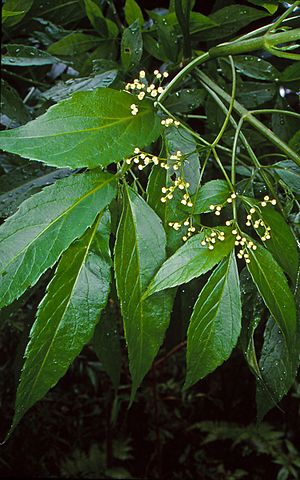Yellow elderberry facts for kids
Quick facts for kids Yellow elderberry |
|
|---|---|
 |
|
| In Budawang National Park | |
| Scientific classification | |
| Genus: |
Sambucus
|
| Species: |
australasica
|
| Synonyms | |
|
|
The Sambucus australasica, often called yellow elderberry, native elderberry, or native elder, is a type of flowering plant. It belongs to the Adoxaceae family. This plant is found only in eastern Australia, meaning it is endemic there. It grows as a shrub or a small tree.
Its leaves have a special shape called pinnate, which means they have smaller leaflets arranged along a central stem. These leaves also have rough, jagged edges. The plant produces small white flowers with three petals. Later, it grows yellow fruits. You can usually find the yellow elderberry growing in or near rainforests.
What Does It Look Like?
The yellow elderberry is a shrub or a small tree. It can grow up to about 4 meters (about 13 feet) tall. Its stems, leaves, and flowers are glabrous, which means they are smooth and have no hair.
Its leaves are pinnate, meaning they look like a feather with smaller leaves branching off. Each leaf is between 60 and 250 millimeters (about 2.4 to 9.8 inches) long. They grow on a stalk called a petiole, which is 20 to 100 millimeters (about 0.8 to 3.9 inches) long. Each leaf has three or five smaller leaflets. These leaflets are narrow and shaped like a spear, wider at the base and narrower at the tip. They are 20 to 100 millimeters (about 0.8 to 3.9 inches) long and 4 to 30 millimeters (about 0.16 to 1.2 inches) wide. Their edges are coarsely toothed, like a saw. Each leaflet has its own tiny stalk, called a petiolule, which is 2 to 5 millimeters (about 0.08 to 0.2 inches) long.
The flowers of the yellow elderberry smell sweet. They grow in groups that are 100 to 200 millimeters (about 3.9 to 7.9 inches) wide. Each flower has three white petals, which are about 3 millimeters (about 0.12 inches) long. This plant usually flowers from October to March. After flowering, it produces a yellow fruit. This fruit is oval or round and is a type of drupe, which means it has a fleshy outer part and a hard pit inside, like a peach. The fruit is about 5 millimeters (about 0.2 inches) across.
How It Got Its Name
The yellow elderberry was first officially described in 1838. A scientist named John Lindley gave it the name Tripetelus australasicus. He wrote about it in a book by Thomas Mitchell, called Three Expeditions into the interior of Eastern Australia.
Later, in 1891, another scientist named Karl Fritsch changed its name. He renamed it Sambucus australasica. This new name was published in a book by Adolf Engler and Karl Anton Prantl called Die Natürlichen Pflanzenfamilien.
Where It Grows
The Sambucus australasica is found in many places along the coast of Queensland and New South Wales in Australia. It also grows further inland, in areas like Rylstone and Tamworth.
However, it is quite rare in Victoria. In that state, you can only find it in the very far north-east part. This plant mostly grows inside or on the edges of rainforests.
See also
 In Spanish: Sambucus australasica para niños
In Spanish: Sambucus australasica para niños

